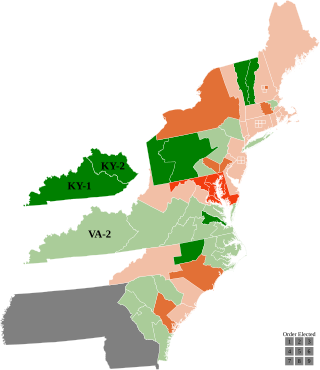
The Vermont General Assembly is the legislative body of the state of Vermont, in the United States. The Legislature is formally known as the "General Assembly", but the style of "Legislature" is commonly used, including by the body itself. The General Assembly is a bicameral legislature, consisting of the 150-member Vermont House of Representatives and the 30-member Vermont Senate. Members of the House are elected by single and two-member districts. 68 districts choose one member, and 41 choose two, with the term of service being two years. The Senate includes 30 Senators, elected by seven single-member and nine multi-member districts with two or three members each. It is the only state legislative body in the United States in which a third party has had continuous representation and been consecutively elected alongside Democrats and Republicans.

The 1790–91 United States House of Representatives elections were held on various dates in various states between April 27, 1790, and October 11, 1791. Each state set its own date for its elections to the House of Representatives before or after the first session of the 2nd United States Congress convened on October 24, 1791. This was the first midterm election cycle, which took place in the middle of President George Washington's first term. The size of the House increased to 67 seats after the new state of Vermont elected its first representatives.

The Vermont House of Representatives is the lower house of the Vermont General Assembly, the state legislature of the U.S. state of Vermont. The House comprises 150 members, with each member representing around 4,100 citizens. Representatives are elected to a two-year term without term limits.

Elections in Vermont are authorized under Chapter II of the Vermont State Constitution, articles 43–49, which establishes elections for the state level officers, cabinet, and legislature. Articles 50–53 establish the election of county-level officers.

The 1790–91 United States Senate elections were held on various dates in various states. These U.S. Senate elections occurred during the first midterm election cycle, which took place in the middle of President George Washington's first term. As these elections were prior to the ratification of the Seventeenth Amendment in 1913, senators were chosen by state legislatures. Senators were elected over a wide range of time throughout 1790 and 1791, and a seat may have been filled months late or remained vacant due to legislative deadlock. In these elections, terms were up for the nine senators in Class 1.

Vermont was admitted at the end of the First Congress, with the admission taking effect at the start of the Second Congress. Vermont was entitled to elect two representatives. Vermont law at the time required a majority to win an office. In the 1st district, no candidate won a majority, necessitating a run-off.

Due to Vermont's election law requiring a majority to secure a congressional seat, the 1st district required three ballots to choose a winner.

Vermont elected its members On September 1, 1818.

Following the September 1808 election for delegates to represent Vermont in the 11th United States Congress, two of its four districts had failed to choose representatives. A second ballot was held in December, giving Vermont a total of three Federalist representatives and one Democratic-Republican.

Vermont law required a majority for election, which frequently mandated runoff elections. The 2nd, and 3rd districts both required second elections in this election cycle, and the 3rd district required a third election.

Vermont elected its members November 4, 1810.

Vermont had no apportionment in the House of Representatives before 1790 census because it was not admitted to the Union until 1791. Vermont's election laws at the time required a majority to win election to the House of Representatives. If no candidate won a majority, a runoff election was held, which happened in the 1st district.

Majority vote required to win, necessitating a run-off election in the 1st (Western) district.

Only 1 of the 2 Vermont incumbents were re-elected.

Vermont elected its members September 2, 1806.

Vermont elected its members September 5, 1826. It required a majority for election, which was not met on the first vote in two districts, requiring additional elections held December 4, 1826 and February 5, 1827.

Only one of the two Vermont incumbents was re-elected.
This page is based on this
Wikipedia article Text is available under the
CC BY-SA 4.0 license; additional terms may apply.
Images, videos and audio are available under their respective licenses.




